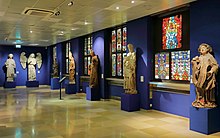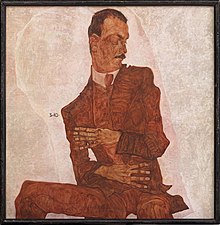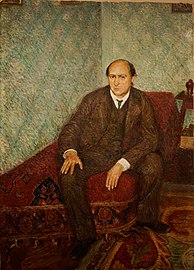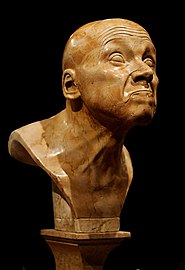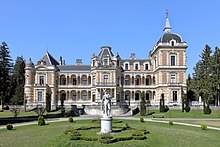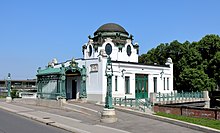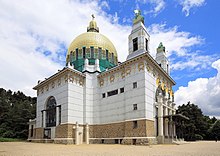
Leopoldstadt is the 2nd municipal district of Vienna in Austria. As of 1 January 2016, there are 103,233 inhabitants over 19.27 km2 (7 sq mi). It is situated in the heart of the city and, together with Brigittenau, forms a large island surrounded by the Danube Canal and, to the north, the Danube. It is named after Leopold I, Holy Roman Emperor. Due to its relatively high percentage of Jewish inhabitants before the Holocaust, Leopoldstadt gained the nickname Mazzesinsel. This context was a significant aspect for the district twinning with the New York City borough Brooklyn in 2007.
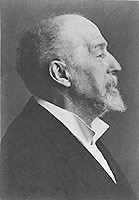
Otto Koloman Wagner was an Austrian architect, furniture designer and urban planner. He was a leading member of the Vienna Secession movement of architecture, founded in 1897, and the broader Art Nouveau movement. Many of his works are found in his native city of Vienna, and illustrate the rapid evolution of architecture during the period. His early works were inspired by classical architecture. By mid-1890s, he had already designed several buildings in what became known as the Vienna Secession style. Beginning in 1898, with his designs of Vienna Metro stations, his style became floral and Art Nouveau, with decoration by Koloman Moser. His later works, 1906 until his death in 1918, had geometric forms and minimal ornament, clearly expressing their function. They are considered predecessors to modern architecture.

The 1873 Vienna World's Fair was the large world exposition that was held from 1 May to 31 October 1873 in the Austria-Hungarian capital Vienna. Its motto was "Culture and Education".
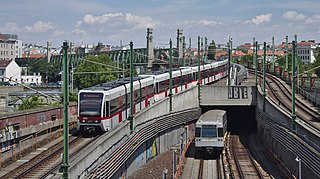
The Vienna U-Bahn, where U-Bahn is an abbreviation of the German word Untergrundbahn, is a rapid transit system serving Vienna, Austria. The five-line network consists of 83.1 kilometers (51.6 mi) of route, serving 109 stations. 459.8 million passengers rode the U-Bahn in 2019.

The Vienna Secession is an art movement, closely related to Art Nouveau, that was formed in 1897 by a group of Austrian painters, graphic artists, sculptors and architects, including Josef Hoffman, Koloman Moser, Otto Wagner and Gustav Klimt. They resigned from the Association of Austrian Artists in protest against its support for more traditional artistic styles. Their most influential architectural work was the Secession exhibitions hall designed by Joseph Maria Olbrich as a venue for expositions of the group. Their official magazine was called Ver Sacrum, which published highly stylised and influential works of graphic art. In 1905 the group itself split, when some of the most prominent members, including Klimt, Wagner, and Hoffmann, resigned in a dispute over priorities, but it continued to function, and still functions today, from its headquarters in the Secession Building. In its current form, the Secession exhibition gallery is independently led and managed by artists.

The Innere Stadt is the 1st municipal district of Vienna located in the center of the Austrian capital. The Innere Stadt is the old town of Vienna. Until the city boundaries were expanded in 1850, the Innere Stadt was congruent with the city of Vienna. Traditionally it was divided into four quarters, which were designated after important town gates: Stubenviertel (northeast), Kärntner Viertel (southeast), Widmerviertel (southwest), Schottenviertel (northwest).

Karlsplatz Stadtbahn Station is a former station of the Viennese Stadtbahn. The buildings above ground on Karlsplatz are a well-known example of Jugendstil architecture. These buildings were included in The Vienna Secession, as they followed many of the artistic styles of that movement. They were designed by Otto Wagner, adviser to the Transport Commission in Vienna, and Joseph Maria Olbrich and are, unlike the other Stadtbahn stations, made of a steel framework with marble slabs mounted on the exterior. These stations allowed Otto Wagner to achieve his goal of creating two modern axes of architecture in a city that was becoming one of the most modern cities of its time. These buildings went on to become the most modern monument of the modern city. Architectural critic and poet Friedrich Achleitner commented on the Stadtbahn stations as follows "...In these two station buildings Wagner reached a highpoint of his dialectic between function and poetry, construction and decoration, whereby a severe rationalism engages in competition with an almost Secessionist kind of decoration."

Karlsplatz is a town square on the border of the first and fourth districts of Vienna, Austria. It is one of the most frequented and best connected transportation hubs in Vienna. The Karlskirche is located here.
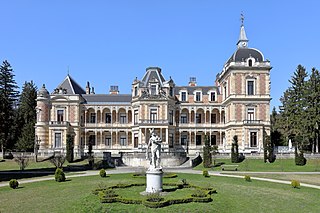
Hermesvilla is a palace in the Lainzer Tiergarten in Vienna, a former hunting area for the Habsburg nobility. Emperor Franz Joseph I gave it to his wife Empress Elisabeth, and he called it the "castle of dreams.“ The name of the villa refers to a statue of Hermes made of white marble that is located in the garden of the villa. Today, the Hermesvilla is noted for its art and natural setting, and is used by the Vienna Museum for special exhibitions on cultural history.
The Wienzeile is a street in Vienna, which originated in the course of the regulation of the Vienna River between 1899 and 1905 along the river's banks.

The Künstlerhaus in Vienna's 1st district has accommodated the Künstlerhaus Vereinigung since 1868. It is located in the Ringstrassenzone in between Akademiestraße, Bösendorferstraße and Musikvereinsplatz.

The Nussdorf weir and lock are works of hydraulic engineering located in the Viennese suburb of Nussdorf at the point where the Donaukanal leaves the Danube. Designed by Austrian architect Otto Wagner, The weir and lock were built following the adoption of a new law in July 1892, which also authorised the construction of the Vienna Stadtbahn and the transformation of the Donaukanal into a winter harbour.
Franz Rosei is an Austrian sculptor and draughtsman. His brother is the writer Peter Rosei.

Erika Abels d'Albert (1896–1975) was an Austrian painter and graphic artist.

Erwin Puchinger was a Viennese painter, illustrator, industrial designer and graphic artist. He was an influential figure in Viennese art in the fin-de-siecle. Puchinger was a part of the Austrian Jugendstil and Gesamtkunstwerk movements, which sought to erase the boundaries between fine art and applied art. Puchinger worked in London, Prague and Paris as well as Vienna and collaborated with other major figures in Viennese art and design such as Ernst and Gustav Klimt and Otto Prutscher. He was a respected art professor at the Graphic Arts Institute, where he taught for more than thirty years. His work was also part of the painting event in the art competition at the 1936 Summer Olympics.
Pilgramgasse is a station on the Vienna U-Bahn line U4. It is located in Margareten between Ramperstorffergasse and the eponymous street, which is named after Franz Anton Pilgram (1699–1761), an Austrian Baroque architect. The station is in an open cut parallel to the River Wien and curves to match the curve of the river.

Hietzing is a station on U4 of the Vienna U-Bahn. It is located beside the canalised Vienna River, on the border of the Viennese districts Hietzing and Penzing, and at the north-western corner of the grounds of the Schönbrunn Palace. It opened as part of the Wiener Stadtbahn in 1898 and became an U-Bahn station in 1981.

Leopold Forstner was an artist who was part of the Viennese Secession movement, working in the Jugendstil style, focusing particularly on the mosaic as a form.

The following outline is provided as an overview of and topical guide to Vienna:

The Burning Child is a 2019 American-Austrian feature documentary film directed by Joseph Leo Koerner and Christian D. Bruun. Created by Harvard art historian Joseph Koerner, the film explores Viennese architectural Modernism through the story of Koerner's father, painter Henry Koerner, who escaped Vienna after Adolf Hitler's annexation of Austria. Part documentary, part personal narrative, part dream sequence, the film explores themes of home, landscape, memory, trauma, repetition, and exile. The film began streaming on Amazon Prime in 2022. A new German version of the film, titled Wohnungswanderung,premiered May 7 2024 as the inaugural film presentation at the newly expanded Wien Museum.



